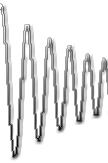 |
 |
|
 |
 |
|
|
|||||||
| Signals | Systems | System Response | |||||
| Frequency Representation | Fourier Series / Transforms | Background Material | |||||
Here is a short review of information that should have been covered in detail in differential equations.
First-order differential equations
First-order differential equations have a solution in the form of an exponential.
For example,
![]()
Integrating Factors
Integrating factors are usually the simplest way to solve any first order differential equations you may encounter in this class. The integrating has the form of.
![]()
To solve a first order differential equation with an integrating factor, we must rearrange the equation into the form shown above. We can then solve for F(t). Next, we multiply F(t) across the equation
![]()
Using the multiplication property of derivatives, we can rewrite the left side of the equation,
![]()
integrate, and divide across the equation by the integrating factor to arrive at our solution.

Second-order differential equations
General Solution:
To solve a second order differential equation of the form
![]()
First we must rewrite the equation as
![]()
Where:



To solve for the general solution, we set the R(t) term to 0.
Then, we can guess a solution:
![]() and proceed to solve for ‘r’.
and proceed to solve for ‘r’.
Our general solution for the second order differential equation then has the form of,
![]()
where the constants c1 and c2 can be solved with initial conditions.
Solving for the transfer function F(jw) using Fourier transforms
Once we have a differential equation in the form of:
![]()
We can manipulate it into a form we are more familiar with. We know that when we have an input of ‘X’ convolved with a system with a transfer function ‘H,’ we will get the output ‘Y.’ This relationship is represented in the frequency domain as
Let’s take the Fourier transform of the differential equation term-by-term keeping in mind the property
![]()
We can apply this property to each term of the differential equation shown below.
![]()
Then, using the multiplication property of the Fourier transform of convolution, we can solve for H(jw).

This is important if you are given a system in the form of a differential equation and need to determine the transfer function (![]() ) from there. In physics and applied engineering, sometimes it is easier to model the system as a differential equation and use this method to solve for the transfer function.
) from there. In physics and applied engineering, sometimes it is easier to model the system as a differential equation and use this method to solve for the transfer function.
|
For comments and suggestions on this page, please click the link below: |